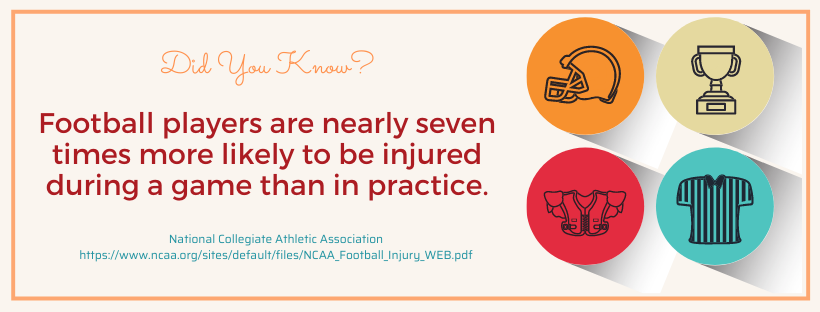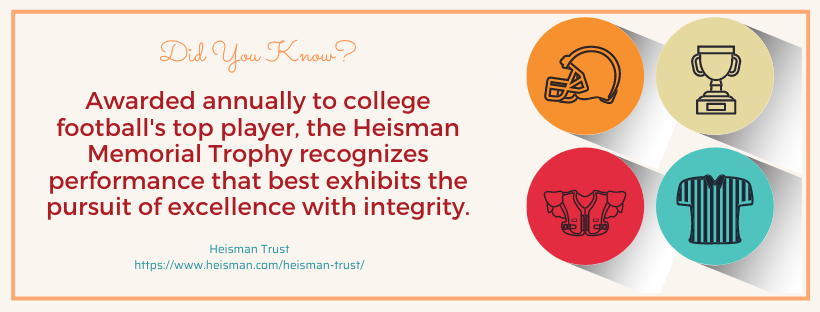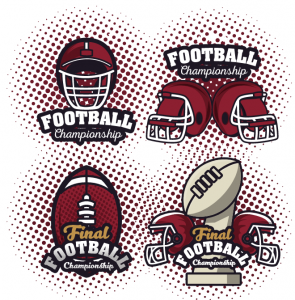15 Best College Football Players of All Time
Find your perfect college degree
In this article, we will be covering...
College football is—by all sports standards—one of the most popular in the United States. With college students as players, this sport is extremely competitive! Everyone playing on the football field dreams of becoming the best football player ever.
College football coaches start scouting potential players from the best high school football players to grace their college team. It’s not uncommon for a college football game to sell out in minutes and, during games, large stadiums are—without fail—jam-packed with intense fans and alumni, all screaming at the top of their lungs rooting for their team.
College Football Explained
Explaining college football to an amateur often ends up gathering more questions than answers. Ever wondered why so many root for a college football team representing universities that they never actually attended? Why are there ten teams in the Big 12, and 12 teams in the Big 10? What in the world is a Hokie?
To further explain college football basics, here are some frequently asked questions to make you understand America’s second most-loved sport.
What comprises a major college football?
In the NCAA (National Collegiate Athletic Association), college football comprises four levels, but the most important is the Football Bowl Subdivision (FBS). The three other levels are the FCS (Football Championship Subdivision), Division II, and Division III.
The Football Championship Subdivision is divided into 11 conferences. However, the Army and Navy, Notre Dame, and Brigham Young University are FBS schools not connected with a conference. Of these 11 conferences, six are considered major: the Southeastern Conference, Big XII, Big 10, Pac-12, the Big East, and Atlantic Coast Conference.
The SEC (Southeastern Conference) mostly constituted public institutions in the previous confederacy. This conference is dubbed as the country’s best football conference because its member institution won national championships in each of the recent six seasons.
The Big XII, on the other hand, is based in Texas. They pride themselves on the Longhorns of Texas and the Sooners of Oklahoma. Although the league still has power, it has significantly lost four members in the past conference and only added two schools. This explains the discrepancy between the name of the conference and its membership.
The nation’s oldest conference, the Big 10, comprises big land-grant colleges from the Midwest. They are represented by Michigan, Ohio State, Penn State, and Nebraska. Since its founding in 1917, the conference has retained its name despite Nebraska’s addition in 2011 and Penn State in 1993.
The Pac-12 is composed of schools from the Rocky Mountain regions and the Pacific Coast. Leading the way are Southern California, Stanford, and Oregon. The ACC (Atlantic Coast Conference) stretches from Miami in the south (Miami, Florida State, and Virginia Tech) to Boston College in the north. And then there’s the Big East.
Although recent disagreements consider this conference in name only, they will soon feature teams from as far as San Diego– the state that used to house major college programs on the eastern seaboard.

How do they determine a champion?
Each team aims to finish a regular football season either first or second in the BCS rankings. It qualifies them to play in the national championship game. In each regular season, the majority of the games are played against other teams of their conference.
The Big 10 and SEC play eight games per season, while the Pac-12 and Big XII play nine. Teams in the Big Eat only play seven games, considering they only have eight football-playing teams.
A conference champion is announced after each regular season. In the case of the Big 10, Pac-12, ACC, and SEC, their champion is ruled on a winner-take-all championship game. The Big East and Big XII are given to the team with an outstanding record during regular season intra-conference games.
The champions and four additional teams from six major leagues are then asked to join the five BCS bowl games. These include the Fiesta Bowl in Phoenix, the Orange Bowl in Miami, New Orleans’ Sugar Bowl, Pasadena’s Rose Bowl, and the BCS National Championship Game.
Games are played in either of the four sites of other major bowl games. The first and second emerging teams based on the BCS rankings are then invited to play in the BCS championship game. The winner is then named as the BCS champion.
Rankings of the BCS heavily rely on computer algorithms and human polls to identify the country’s best two teams. For a team to earn the coveted spot in the contest, it has to be a member of any of the six major conferences, and that should win all the games of the regular season.
Why are teams ranked even before a season starts? How are they ranked?
Before a season starts, select FBS coaches and members of the media covering the sport are asked to rank who they think will emerge as the top team during the upcoming season. Although these are speculating rankings, the polls will largely be based on a team’s performance during the previous year. The team’s level of talent is also considered and the quality of all incoming players.
During the season, pollsters are regularly required to re-rank the teams to factor in the previous game week’s result. The ranked team that wins normally maintains its ranking position or even moves up. However, these rankings are not scientific. They are mostly based on the personal opinions of the pollsters.
In determining the top two teams qualified for the national championship, a computer algorithm is used. But this does not factor into a human poll. Meaning, that while Alabama is deemed as the best team at present based on the rankings made by coaches and media personnel, this is just a matter of opinion and not really of a fact.
Nevertheless, polls play a huge part in determining the players qualified for the national championship, making these rankings extremely important.
In 2005, the Associated Press poll was removed from determining the top two teams in the country and was replaced by the Harris Interactive Poll. This is composed of coaches, former college football players, non-AP journalists, and college administrators.
What is a Heisman Trophy?
The Heisman Memorial Trophy is annually given to the most outstanding football player in the United States. It is named after John W. Heisman, a coveted college football coach who was also the New York Downtown Athletic Club’s athletic director.

Preparing for College Football 2024
Now that you’ve learned the basics and the importance of college football, and you were inspired after reading the stories of the best college football players of all time, perhaps you feel like you are called to join college football. So how do you prepare for that?
- Be a high school standout. College football recruiters believe that the junior years are the best time to prepare to attract the attention of coaching staff across the country. Most of today’s coaches are not only after your physical capabilities. They will also check your mental preparedness. They just don’t want a talented player. They need a student of the game. So it’s best to be physically, mentally, and academically prepared while still in high school. Despite the NCAA’s flaws, they still require some minimum academic standards that players should meet.
- Step up on your senior year. For most college football recruits, the last year in high school is challenging. You need to keep up with the pressure of performing at your best level possible. At the same time, you must step up your game academically! Don’t forget how crucial the SAT or ACT is. While college footballs don’t require high test scores, you still need to ace that test, especially if you plan on attending universities like Michigan or Stanford.
- Prepare for the “after the senior season.” A high school football season ends every November. But that should not prevent college-bound players from practicing. Every day, you can find the top recruits in the gym, on the track, or in the weight room, preparing.
- Strength Training. Once you are admitted to college, the first time you step onto the field can be intimidating. After all, you will be facing grown-up and experienced athletes five years your senior. They are faster, bigger, stronger, and are nearing their lifetime physical peak. So how can you cope with that? Everything begins with strength training. After your high school football season ends, it’s okay to take some rest for a month or two, or just right around your Christmas break. After that, start hitting the weights. And hit them hard. Doing weight training four days a week is normal. Split your routines. Alternative your lower and upper body days. Chest exercises, shoulder workouts, and the like can help add muscle mass needed to go through the next level. Jumps, leg curls, lunges, leg presses, and calf extensions should comprise your lower body routines. Strength is very critical for a football player on the field.
- Speed Training. Incoming first-year students should create that instant impact on their coaches with bursts of speed when camps get underway. The most common difference a newcomer will notice from high school to college football is the guys’ speed that will come to tackle you. College football is fast. And quarterbacks throw the ball faster. Linebackers pursue faster, and running backs run quicker. A conditioning coach should be able to help you with your running techniques. Of course, you need to run, run, and run some more.
- Summer Camps. No, this is not about counselors or cabins, outdoor camps, or swimming holes. Summer camps for new athletes help them transition from high school to the collegiate league. In a football summer camp, this is an informal sort of training. You meet your teammates, and together, you work on conditioning yourselves physically and mentally.
Why are People Crazy Over College Football?
The US is a country obsessed with sports, although its sports are generally local. College football goes around regions, cities, and towns that almost all professional sports neglect. Plus, college football is loved by many and passed down from one generation to the next.
Additionally, fans of college sports don’t have to deal with the awkward fact that he/she may be hanging on the game result of strangers who are making more money in a year than he/she can make in a lifetime. Players in college sports are also considered and hailed as hometown heroes, no matter where they originally come from.
Why is College Football More Popular than Professional Football?
Although college football games are far behind the NFL’s professional version of the sport, football fans are surprisingly more interested in watching college football games. There are so many reasons behind this.
The college spirit is very strong. This is perhaps the very reason why college football games are more enjoyable than their professional version. Because of that collegiate spirit attached to a football game, the game is more fresh and enjoyable. Plus, games played by college types usually have no tags attached to them.
Pride and prestige. When players of a university play, they become the pride of their college and region. People root for their team at each game, and students are encouraged to enroll in the university! And even if they did not play the football game themselves, it’s not a surprise to hear them using the word “our” when they talk about their favorite school or college. Somehow, this becomes an issue of pride and prestige for them to express in several ways, including college sports.
College games make a great medium for social gatherings. College alumni who wish to travel down memory lane and reminisce about their college years can do so by attending college games. These games are perfect occasions for social gatherings for these alumni to share and refresh their memories with their friends. For the most part, college games are the best season for grilling, tailgating, parties, and gathering good food and memorable conversations.

So who are the top 15 best college football players of all time? Lamar Jackson? Tim Tebow? We’ve created a list of the 15 greatest college football players ever.
Best College Football Players of All Time

Herschel Walker
Position: Running Back (RB)
Georgia Bulldogs
University of Georgia
Of the many great college football players, there is only one Herschel Walker. Some of the players dominated for just a season or two. Walker made it three. And that is why he is on top of the list. A bulldog among all other Bulldogs, this sports hero was the University of Georgia‘s running back.
Walker was a three-time All-American player for the Bulldogs and a winner of the Maxwell Award and Heisman Trophy back in 1982. Of the hundreds of successful college football players, he is the only athlete to land in the top three in Heisman polls in all of his three collegiate seasons. He was also the first NCAA player ever to play in only three years to get in the top 10 in rushing yards.

Archie Griffin
Position: Running Back (RB)
Ohio State Buckeyes
The Ohio State University
In 1972-75, Archie Griffin played college football for the Ohio State University Buckeyes. Griffin won the starting position during his freshman year, something that did not sit well with many sophomores because they felt Griffin took their spot. In 1972, Griffin was the school’s T-formation halfback.
A year later, he became the I-formation tailback for two years, from 1973-1975. As a freshman, he led their team with 867 yards. His number grew after a year following their team’s conversion to the I-formation. There, he rushed 1,428 yards during the regular season as a sophomore, then 1,620 yards as a junior, and finally 1,357 yards as a senior.
In total, Griffin rushed for 5,589 yards on 924 in all four seasons with the Buckeyes. Back then, it was an NCAA record (1972-1975). He also scored 26 touchdowns and 6,559 all-purpose yards.

Tommie Frazier
Position: Quarterback (QB)
Nebraska Cornhuskers
University of Nebraska
Tommie Frazier was the pride of the University of Nebraska as a quarterback. He led his team to win consecutive national championships in 1994-1995, one of the five quarterbacks to successfully do so since the 50s: Jerry Tagge of Nebraska, Steve Davis of Oklahoma, Matt Leinart of US, and AJ McCarron of Alabama.
He was one of the five players to score consecutive national championships that included zero ties or losses. He was named MVP for leading his team to three national championships—the only known player to ever accomplish such a feat. During his stint as a quarterback, the Nebraska football team was one of the most dominant teams in college football history in the US.

Hugh Green
Position: Defensive End (DE)
Pittsburgh Panthers
University of Pittsburgh
Hugh Green was the University of Pittsburgh Panthers defensive end player when he played from 1977 to 1980. Back then, he was part of a team that included future NFL players Rickey Jackson (defensive end), Russ Grimm (center), and Dan Marino (quarterback). Green was a 3-time consensus first-team All-American (1978-1980), and a second-team All-American selection in 1977.
In his four years at the Pittsburgh Panthers, he compiled a 39-8-1 record. He won three bowl games as well (one Fiesta Bowl and two Gator Bowls). By the time he left the university, Green had recorded 460 tackles and 53 career sacks during his college career.
In 1996, Green was named the 5th greatest college football player of all time. He was also awarded the College Football Hall of Fame award in that same year. ESPN ranked Green on the 14th spot of their Top 25 Players in College Football History in 2007.

Barry Sanders
Position: Running Back (RB)
Oklahoma State Cowboys
Oklahoma State University
Born July 16, 1968, Sanders is a professional football player for the Detroit Lions of the National Football League. During his college years, he was a star player on the Oklahoma State University Cowboys football team. As a junior back in 1988, he compiled what is dubbed as one of the best individual seasons in the college’s history, rushing 2,850 yards and 42 touchdowns in 12 games.
He earned the Heisman Trophy award for being the most outstanding college player in the nation. In 1998, he was inducted into the Kansas Sports Hall of Fame, and then into the College Football Hall of Fame in 2003. In that same year, Sanders was inducted into the Michigan Sports Hall of Fame.

Dick Butkus
Position: Linebacker/Center (LB/C)
Fighting Illini
University of Illinois
Dick Butkus attended the University of Illinois and played as linebacker and center for the Illinois Fighting Illini football team from 1962-1964. During his first year, Butkus was named by the Associated Press as the third-term center to the 1962 All-Big Ten Conference football team and the United Press International’s second-team center.
Illinois defeated Washington in the 1964 Rose Bowl in an 8-1-1 record. His team awarded him the Most Valuable Player award for the season and the Chicago Tribune Silver Football as the MVP of the Big Ten. In 1963, he was unanimously chosen for the College Football All-America team.
In his senior year in 1963, Butkus became the co-captain of their team and George Donnelly. UPI chose him as Lineman of the Year in 1964 and the Player of the Year by the Sporting News and the American Football Coaches Association.

Howard Cassady
Position: Running Back (RB)
Ohio State Buckeyes
Ohio State University
Howard Albert “Hopalong” Cassady was a successful American professional football player. In 1955, he won the Heisman Trophy. More than two decades later, he was inducted into the College Football Hall of Fame in 1979. During his college day, he played for the Ohio State University Buckeyes from 1952-1955. As a running back, he scored 37 touchdowns in 36 games.
Although he was also a defensive back, a pass did not happen throughout his four years at the university. In 1954-1955, he was picked as a consensus All-American. Their team also finished the season in 1954 on a 10-0 streak and eventually won a national championship. During that year, Cassady placed third for the Heisman Trophy, following Wisconsin’s Alan Ameche.
A year after that, he finally won the top award of the Heisman Trophy. He also got the Maxwell Award, and the Associated Press named him the Athlete of the Year. He earned his “Hopalong” nickname during his first year of playing for Ohio State. Sportswriters from Columbus saw him play, and apparently, Cassady ‘hopped’ all across the field like he was a performing cowboy, a reference relative to Hopalong Cassidy.

Marcus Allen
Position: Running Back
USC Trojans
University of Southern California
Marcus Allen was a running back at the University of Southern California from 1978 to 1981. Head coach John Robinson initially recruited him as a defensive back until he was switched to tailback. During his freshman year in 1978, he also took part in the Trojan’s National Championship Team, where he played as a backup to a later Heisman Trophy awardee Charles White. A year later, Allen was moved to fullback.
In 1980, Allen was the starter at tailback, where he rushed 1,563 yards. During that time, it was the nation’s third-most, just behind South Carolina’s George Rogers of 1,781 yards and Georgia’s Herschel Walker of 1,616 yards.
A year later, he rushed 2,342 yards, becoming the second player in the whole of NCAA history to run for over 2,000 yards in just one season. He also has 2,683 offensive yards and eventually won the Maxwell Award, Heisman Trophy, Walter Camp Award, and Pac-10’s Player of the Year. After completing his four college seasons, his record showed he has 4,664 running yards, 5,232 total yards, and 46 touchdowns, averaging at 5.2 yards per carry.

Tim Tebow
Position: Quarterback (QB)
Florida Gators
University of Florida
Born Timothy Richard Tebow, this current American professional baseball player was once a professional football quarterback. He was the University of Florida’s quarterback and was awarded the Heisman Trophy in 2007. He accepted an athletic scholarship and played for the University of Florida’s Florida Gators Football team from 2006-2009. He initially served as a backup during his freshman year.
Eventually, he led his team to a BCS championship in 2008. A year later, the Gators won a 13-1 record in 2009. He was picked as a team captain in 2008 by the Gator’s coaches. By 2009, he was the very first three-time recipient of the Gator’s MVP award.
During that same year, he opened the season by continuously throwing and running for a touchdown. They successfully won over Troy and Charleston Southern. In the third game, they won yet again against Tennessee. However, he failed to successfully throw for a touchdown, his very first ever since his freshman season.
After college, he held 28 University of Florida statistical records, 14 Southeastern Conference, and 5 National Collegiate Athletic Association. He was the all-time leader of the SEC in terms of completion percentage (67.1%), passing efficiency (170.8), rushing yards (2,947), rushing touchdowns (57), passing touchdown to interception ratio (5.5 to 1), and a total touchdown of 145.

Vince Young
Position: Quarterback (QB)
Texas Longhorns
University of Texas
Before Vincent Paul Young became a professional football quarterback, he played for the University of Texas from 2002-2005 under coach Mack Brown’s Texas Longhorns football team. He won the Davey O’Brien Award in his junior year, a citation annually given to the best college quarterback in the country. He also has a Heisman Trophy, finishing second after Reggie Bush.
Following the Heisman voting, Young led his team to the BCS National Championship in the 2006 Rose Bowl, playing against the USC Trojans, the defending BCS national champion. He accounted for 467 yards (267 passing, 200 rushings) and three rushing touchdowns. This led their team to a 41-38 victory. Because of the victory, he was awarded the Rose Bowl MVP Award.
During his early years in college, Young was criticized as a “great usher but an average passer,” together with his weird throwing motion that was said to be a “side-arm.” Nevertheless, he could still reach a win/loss record of 30-2 as a starter, making him the university’s number 1 quarterback by the number of wins.

Tommy Nobis
Position: Left Guard/ Offensive Guard (LG/OG)
Texas Longhorns
University of Texas
Before becoming a professional football linebacker playing for the National Football League for 11 seasons, Thomas Henry Nobis Jr. played at the University of Texas. During his time, he was one of the all-time greatest linebackers in the history of college football. He played for the Texas Longhorns from 1963-1965 and averaged about 20 tackles per game. He played a crucial part in the 1964 national championship team, which toppled the Navy, led by Heisman Trophy awardee Roger Staubach.
Nobis made it to the All-Southwest Conference team three times and was also a two-time All-American. While still in junior year, he made one of the sport’s most famous tackles during the 1965 Orange Bowl. Just holding on to a 21-17 lead, he led his whole team to halt Alabama’s top-ranked Joe Namath.
Tommy Nobis was dubbed as an iron man, playing both offense and defense throughout his college career. Although he was a linebacker, he also played guard on the offensive side and was usually the block on touchdown runs.

Deion Sanders
Position: Cornerback (CB)
Florida State Seminoles
Florida State University
Born Deion Luwynn Sanders, this American athlete, nicknamed Prime Time, is also a coach for 14 seasons in the National Football League and a sports analyst. He attended Florida State University and played track and field, baseball, and football. In his freshman year, he began in the Seminole’s secondary and was the baseball team’s outfield.
By 1986, under the school’s football coach Bobby Bowden, Sanders was a third-team All-American in 1986 and a two-time All-American cornerback in 1987-1988. Throughout his college football career, he was able to intercept 14 passes, including three in bowl games. He also returned one interception roughly 100 yards for an impressive touchdown, breaking Fred Biletnikoff’s one-yard interception return record.
In 1988, Sanders won the Kim Thorpe Award. He was also cited for being a standout punt returner at Florida State. In the 1989 Sugar Bowl, he intercepted with only 5 seconds left to seal a 13-7 Florida State win against Auburn. He finished his career with 1,429 yards and 126 punt returns. Later on, coach Bowden stated that Sanders was his measuring stick when it came to athletic abilities.

Earl Campbell
Position: Running Back (RB)
Texas Longhorn
University of Texas at Austin
Nicknamed The Tyler Rose, Earl Christian Campbell, is a former American professional football player. Back in college, he played for the Texas Longhorns of the University of Texas from 1974-1977. He earned All-America honors and a Heisman Trophy, along with a handful of different accolades. When he was still a freshman back in 1974, he was able to rush 928 yards in all 11 games he played, with six touchdowns on 162 attempts.
A year later, he was included in the first-team All-America selection by the American Football Coaches Association. He led the Longhorns to the Southwest Conference, recording 1,118 rushing yards, 78 points, and 13 rushing touchdowns. Sadly, he had to forgo four games in his junior season because of leg injuries. In 1977, he held the remarkable record of 19 touchdowns and 1,744 yards.
In a game against the Rice Owls in the third game of the season, he scored four touchdowns on a 72-15 win wherein Texas kicker Russell Erxleben set a 67-yard field goal, a new NCAA record back then. Campbell’s final regular game season saw him rushing a career-high 222 yards, defeating Texas A&M in a 57-28 victory.
They ended the season undefeated. After the season, he was awarded the Heisman Memorial Trophy being the most outstanding college player for that season, making him the first University of Texas award.

Peyton Manning
Position: Quarterback (QB)
University of Tennessee Volunteers
University of Tennessee
Former American football quarterback Peyton Williams Manning played for the National Football League for 18 seasons. Dubbed one of the best quarterbacks of all time, Manning started his career playing football for the University of Tennessee Volunteers under Phillip Fulmer, the head coach. During his freshman year in 1994, he started as the third-string quarterback.
In a season opener game played against UCLA, he was one of the team’s three quarterbacks after their starter Jerry Colquitt, suffered an injury on the seventh play of the game. But Manning did not generate any offense. He only handled the ball three times, which eventually got him pulled out of the game.
A year later, Manning and his team began the 1995 season with victories over SEC rival Georgia and East Carolina. After this, they head off to Gainsville to play against the Gators. Against Florida, Manning secured two touchdowns and 326 yards, leading their team to a 30-21 halftime lead.
Still, this was not enough since the Gators eventually outscored them 41-7 in the second half and won 62-37. In that particular season, this game was the only loss of the Vols. They won the remaining eight regular-season games.
Manning received numerous citations like the Maxwell Award, the first-team All-American, the Davey O’Brien Award, and the Johnny Unitas Award. In 1997, he was awarded a Heisman Trophy as the runner-up to Charles Woodson. While in school, he excelled academically and was elected to the Phi Beta Kappa Society and Omicron Delta Kappa. Finally, he was once a national scholar-athlete awardee given by the National Football Association.

OJ Simpson
Position: Running Back (RB)
USC Trojans
University of Southern California
Orenthal James Simpson, popularly known as “The Juice,” was a professional football running back, an actor, an advertising spokesman, and a broadcaster. Setting his criminal record aside, OJ Simpson is one of the greats in football athletics.
Back then, Simpson was an All-City Galileo football player. However, his below-average grades in high school prevented him from getting the attention of interested college recruiters. In 1965 at the City College of San Francisco, Simpson made a name for himself as a defensive back and a running back. He led his team to an awesome win against Long Beach State in the Prune Bowl. The said victory thrust Simpson into the limelight.
As a transfer student for football, he chose the University of Southern California, his dream school. He played as a running back for coach John McKay from 1967-1968. He led the nation in rushing in those two years, with 1,543 yards and 13 touchdowns in 1967 and 1,880 yards on 383 carriers in 1968.
As a senior in 1968, he rushed for 1,709 yards and 22 touchdowns. This garnered him the Heisman Trophy, the Walter Camp Award, and the Maxwell Award. He holds the record for Heisman’s biggest margin of victory for more than five decades, defeating Leroy Keyes by 1,750 points.




